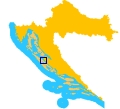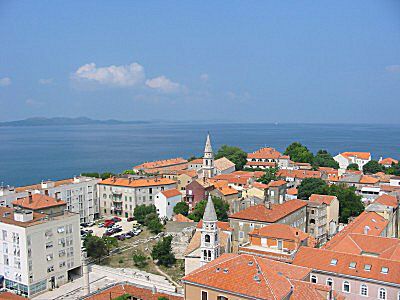Zadar
|
|
Zadar (Italian Zara) is a city in Croatia on the Adriatic Sea, with a population of 72 718 (2001). It is the center of the Zadar county and wider northern Dalmatian region. Zadar is geographically located at 44:26N Latitude, 15:03E Longitude.
| Contents |
History
In the 9th century BC Zadar was settled by the Liburnians, a tribe of Illyrians. After 59 BC Zadar became a Roman municipium, and in 48 BC a colony of Roman citizens. It maintained its autonomy throughout the Middle Ages. Upon the fall of the Western Roman Empire and the destruction of Salona in the early 7th century, Zadar became the capital of the Byzantine province of Dalmatia, as well as the governor's headquarters.
In the early 9th century it came under the Franks, while it was given back to Byzantium in 812, under the Peace Treaty of Aachen. In the 10th, and especially in the 11th century, although it survived the migration of Slavs, the rulers of the town were the Croats. From 1105, when it recognized the rule of the first Hungarian-Croatian king Coloman, Zadar began to be involved in frequent wars with Venice.
Zadar was under the Republic of Venice between 1111 and 1154 and between 1160 and 1183, before it was finally taken by the Venetians and the knights of the Fourth Crusade in 1202. The Crusaders had promised the Venetians a certain amount of money to pay for ships for transport to Egypt, and when they could not pay the Venetians diverted the Crusade to Zadar. King Emeric of Hungary had declared that he would join the Crusade, and there was a controversy among the knights and clergy over whether or not a supposedly divine army could attack a fellow Christian. Nevertheless, Zadar was destroyed and taken, and Pope Innocent III excommunicated everyone involved.
After several insurrections (1242-1243, 1320s, 1345-1346), Zadar came under the rule of the Hungarian-Croatian king Louis I (under the Zadar Peace Treaty in 1358). After the death of Louis, Zadar recognized the rule of king Sigismund, and after him, that of Ladislas of Naples, who, in 1409 sold Zadar and "his rights" on Dalmatia to Venice.
From this time on, Zadar started to decline, because the Venetians considerably limited the town's political and economic autonomy. When in the early 16th century the Ottoman Turks conquered the Zadar hinterland, the town became an important stronghold ensuring the Venetian trade in the Adriatic, as well as the administrative centre of the Venetian possessions in Dalmatia and a cultural centre.
After the fall of Venice (1797) with the Treaty of Campo Formio, Zadar came under the Austrian rule under which it remained until 1918, except for the period of the French rule (1805-1813), all this time remaining the capital of Dalmatia.
During the French rule, the first newspaper in the Croatian language, 'Kraljski Dalmatin', was being published in Zadar (1806-1810). In the second half of the 19th century Zadar was a centre of the movement for the cultural and national revival in Dalmatia. Under the Treaty of Rapallo, 1920, Zadar was ceded to Italy.
The Nazi Germany occupied it in World War II, as the city was once one of the best-fortified cities in the world. Zadar was bombed 72 times by the air forces of Britain and United States during the Second World War. Afterwards it was joined again with Croatia (at the time in Yugoslavia).
Since World War II the city has developed as a strong economic and tourist center. In 1991 the Serbian irregulars and the Yugoslav People's Army (JNA) attacked Zadar and it found itself on the very edge of the occupied territory as the shelling target. Connections with capital Zagreb were cut for over a year, and the only link was via the island of Pag. Zadar was once again severely damaged in the war, including its historical bastions and churches. The siege of the city lasted until January 1993, when the hinterland of Zadar was liberated. Anyway, the attacks continued up to 1995, when the war in Croatia was finished.
- adapted from the "Miroslav Krleza" Lexicographic Institute.
Cultural Heritage
Architecture
Zadar gained its urban structure in Roman times; the time of Emperors Caesar and Augustus, the town was fortified and the city walls with towers and gates were built. On the western side of the town were the forum, the basilica and the temple, while outside the town were the amphitheatre and cemeteries. The aqueduct which was supplying the town with water has been partly preserved. Inside the ancient town, a mediaeval town had developed, when a series of churches and monasteries had been built.
During the Middle Ages, Zadar had fully gained its urban aspect, which has been maintained until today. In the 16th century, Venice fortified the town with a new system of defensive walls on the side facing the land. In the first half of the 16th century, architectural building in the Renaissance style was continued. Defence trenches were built also (Foša), which were completely buried during the Italian occupation. Although in the second half of the 19th century by rule of Austria fortifications were destroyed, wall lines have been preserved until today. In the bombardments during the Second World War, entire blocks were destroyed, but some of the structures having been preserved.
Most important objects:
- Roman Forum - the largest on the eastern side of the Adriatic, founded by the first Roman Emperor Augustus, to which two stone inscriptions about its completion dating from the 3rd century testify.
- Aqueduct
- St. Donatus' Church - the monumental building in the pre Romanesque style from 9th century
- St. Anastasia's Cathedral, basilica in Romanesque style built in the 12th to 13th century
- St. Stosija's Church - ended in the high Romanesque style period, largest cathedral in Dalmatia.
- St. Ilija's Church (St. Elias)
- St. Francis' Church, gothic styled church, site of the signing of the Zadar Peace Treaty 1358
- Five Wells Square
- St. Mary's Church which belongs to a Benedictine Convent founded in 1066 by a noblewoman of Zadar by the name of Cika with The Permanent Ecclesiastical Art Exhibition "The Gold and Silver of Zadar"
- Citadel - built in 1409, southwest of the Land gate, it has remained the same to this day.
- The Land Gate - built according to a layout of the Venetian architect Michele Sanmicheli in 1543
Literature
Zadar was, besides Dubrovnik, one of the centres of development of Croatian language and culture. A annalist from the year 1177 noted that the joyous people of Zadar accompanying Pope Alexander III on his way to the basilica sang songs of praise 'in their native Slavic language'. The first university mentioned in 1396 was a part of the Benedictine monastery.
The 15th and the 16th centuries were marked by important activities of Croatian writers writing in the national language: Jerolim Vidolić, Petar Zoranić (who wrote first Croatian novel "Mountains"), Brne Krnarutić, Juraj Barakovic, Šime Budinić.
During the French rule, the first newspaper in the Croatian language, Kraljski Dalmatin, was being published in Zadar (1806-1810). In the second half of the 19th century, Zadar was a centre of the movement for the cultural and national revival in Dalmatia.
Today's Zadar's cultural instutions:
- The Croatian Theatre House
- The National Museum
- The Archaeological Museum (established in 1830)
- The University of Zadar (founded in 1396)
- The Maritime Museum
- Permanent Exhibition of Sacral Art
- Croatian Singing Musical Society Zoranić (established 1885)
- Musical Evenings in St. Donatus (http://www.kuz.hr/donat.htm) (established 1961)
- International Choir Competition (http://www.kuz.hr/zborovi_2005.html) (established 1997)
Economy
The major industries are tourism, traffic, seaborne trade, agriculture, fishing and fish farming activities, metal manufacturing and mechanical engineering industry, chemicals and non-metal industry and banking. The headquarter of following companies are located in Zadar:
- Maraska (http://www.maraska.hr) (food industry)
- Adria, Mardešić (fish production)
- Tankerska plovidba Zadar (http://www.tankerska.hr) (shipping company)
- SAS (http://www.sas-strojogradnja.biz) (machine tools)
- Aluflexpack (http://www.afp.hr/)
The farmland just northeast of Zadar, Ravni Kotari, is a well known source of marasca cherries. Distilleries in Zadar have produced Maraschino since the 16th century.
Science
In 1998, Zadar hosted the Central European Olympiad in Informatics (CEOI).
Famous people from Zadar
- Georg Ritter von Trapp, Austrian navy officer and head of the Trapp family singers.
External links
- About Zadar County (http://www.zadar.hr/)
- Zadar Airport (http://www.zadar-airport.hr/)
- The University of Zadar (http://www.unizd.hr)
- Zadar City Map (http://sukosan.net/ap/map/zadar.php)bs:Zadar


